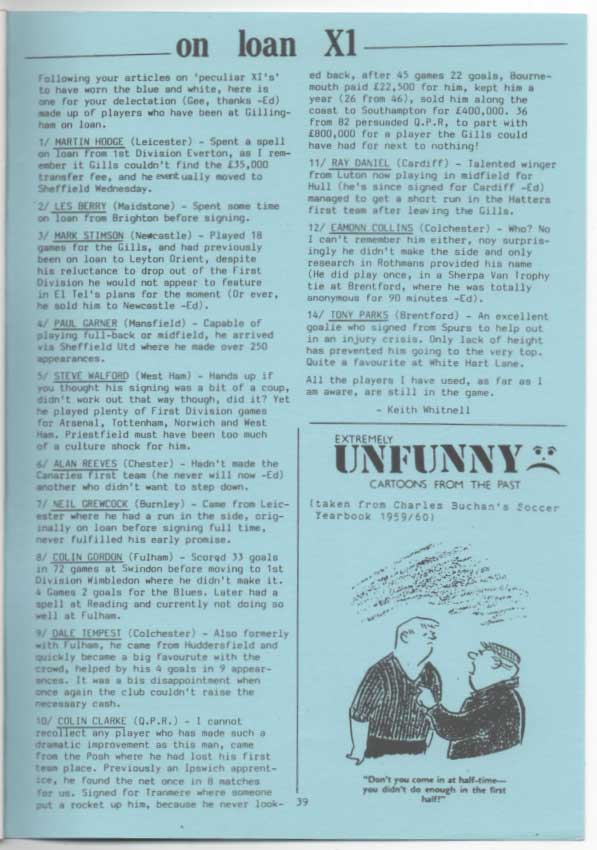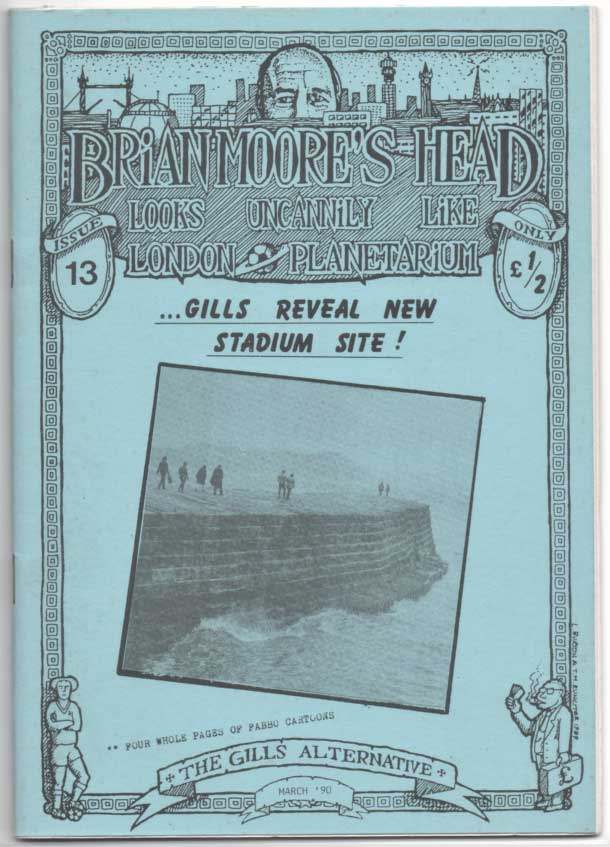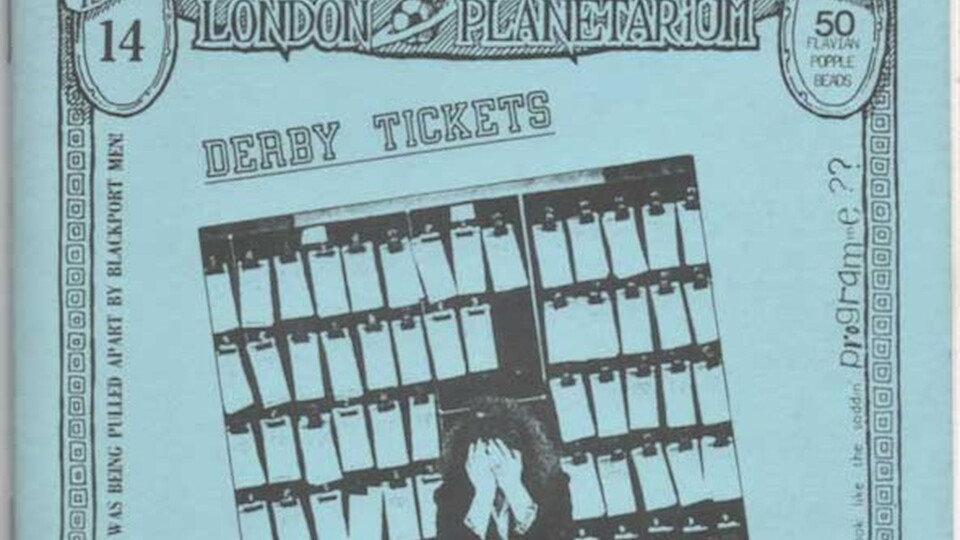Issue thirteen of Brian Moore’s Head was launched on Friday 16 March 1990, at the home league game against Halifax Town.
We usually managed five or six sellers, dotted around Priestfield, each armed with a bag or two of fanzines and some change, in case the affluent were in town, waving fivers and tenners at us for a publication that only cost 50p.
Although crowds were low, with many not usually turning up until fairly late on, we started selling around an hour before kick-off if it was a Saturday, or about three quarters of an hour prior to the start if it was an evening fixture. I usually began by setting up and selling alongside the Gills shop in Redfern Avenue, hoping to attract sales from those going in to cast their eyes over the limited selection of merchandise. The Gills shop was to the current Megastore as a corner shop would be to Tesco.
Half an hour before kick-off, I would usually go into the ground and continue selling, this time at the top of the steps leading to the Rainham End terrace, before packing up around five minutes before the start. Half-time would see another walkabout to try and shift a few more. The problem we encountered a lot of the time was that we all went in the Rainham End, so we usually didn’t have anyone selling inside the Town End. We did eventually recruit someone who did go in the open end and was happy to flog our wares.
With demand for the fanzine high, sales were frequent and it wasn’t an arduous task, the only drawbacks being cold and wet weather. The fanzine was also available by mail order and from places as diverse as London, Nottingham, Birmingham, Tonbridge and Cardiff. Sportspages in the capital used to take, and usually sell, two hundred copies of each issue. As I worked in London, I inherited the cumbersome task of delivering the copies to Sportspages.
I was never very popular when I got on the 7.24 Cannon Street train, carrying a large, heavy box containing two hundred fanzines, when most other commuters just had briefcases. Having taken the box to work, I then had to negotiate the London Underground at lunchtime to complete the task, delivering the fanzines and collecting the cheque for payment for the previous issue. Sales of BMH 13 were brisk at the Halifax game, but launching an issue at an evening fixture was soon discontinued, as fewer copies tended to be sold compared to when we brought out a new edition on a Saturday.
We tended to sell each issue at three home fixtures; at the first we would get rid of hundreds, sales would be fairly decent at the second but, trying to sell at a third game was generally a fruitless endeavour as most people had already got their copies by then.

The editorial in issue 13 bemoaned the lack of quality in our division and the club’s inconsistency, ‘In many ways, this has been an incredibly frustrating season. Several times we have threatened to hoist ourselves into the top positions, only to fail at a crucial time. The fact that the Fourth Division is extremely poor, with no one team outstanding, has meant that we have never entirely lost touch with the leaders, but this has only served to add to the sense of frustration.’ Mention was made of a recent Friday night away game at Colchester United and a poor performance, resulting in a 0-2 defeat, ‘At the end of the ninety minutes, all the team had gained was a protracted chorus of “What a load of rubbish” from the large away contingent.
The players can have no complaint about the abuse they received from the 1,000+ Gills support.’ With fans having endured traffic problems in Medway, roadworks on the A2 and the usual Friday rush hour chaos at the Dartford Tunnel during their journey to the game, their reward was, ‘A display that was completely lacking in the slightest amount of skill or commitment.
It is hard to think of a single redeeming factor for what was surely the most shameful and unprofessional performance produced under Damien Richardson.’ More evidence of the team’s inconsistency was soon provided. The 3-1 victory over Halifax lifted Gillingham up to third in the table, but we then embarked on a run of six successive defeats, in which a total of one goal was scored. By the time the losing sequence was ended, we were in fourteenth position, resigned to another campaign in the basement.
The article ‘Four-eyed Git’ related the problems encountered by glasses wearers at football matches. The writer, back in 1983, having realised that the players were getting a bit fuzzy, duly went along to the opticians to get himself kitted out. The last game he saw before getting his spectacles was a Charlton match at the Valley. It poured hard during the game and the writer stood in an uncovered area, ‘At the time it didn’t cross my mind, but standing on an open terrace would never be the same again.’
Rain would subsequently present more problems for him, apart from the obvious one of getting wet. On an open terrace, trying to watch a game through glasses covered in hundreds of drops of water was tricky, and even worse if the floodlights were on, as the lights glared off all the droplets. Wiping them dry was also not an option as the lenses tended to smear. Gillingham’s 1985 FA Cup tie away at Portman Road highlighted another problem, that of trying to avoid having your glasses knocked off and smashed during goal celebrations, ‘At Ipswich, when we equalised, the celebrations were so exuberant that my glasses were nearly shoved up my nose. We were so jammed in that I couldn’t move my arms to do anything about it and so had to wait for them to slip back down.’
One particular problem occurred when the writer was at Tottenham, standing on the covered Shelf section, as it was raining. Suddenly, his view became fairly weird, one of the little screws holding the lens in the frame had loosened and the lens had dropped out and fallen onto the ground, ‘Once my brain had registered the fact, panic set in. Watching through only one lens was very strange. Fortunately, I found the lens (plastic, and so unbroken) and then had the task of screwing it all back together, using a biro.’
The Head signed off for the season with number fourteen, which looked slightly amateurish in comparison with previous editions, the reason for which was explained in the editorial, ‘May I apologise in advance for the slightly variable nature of some of the typing in this issue. The official BMH ‘leccy typewriter met with a slight accident recently (it plunged headlong off the desk) and, despite a late fitness test, was unable to resume its duties in time to type the last few articles of the season.’
The typewriter that was brought in on an emergency loan deal was of the old-fashioned variety that had obviously seen plenty of previous use. For once, the editorial took on a positive stance, ‘Whatever the outcome, this season has far exceeded the hopes of this BMH editor, genuine worries over our ability to survive in the lower division have proved unfounded, mainly due to a combination of the weakness of the division and, let’s not underestimate this, the performance of Damien Richardson in the hot-seat. Sure, he’s made mistakes, but let’s not forget that he is still learning the job, when you take this into account, he has done remarkably well. Let us hope that both he and the team can build on the solid platform this season has provided.’
Having long since squeezed the life out of the concept, with guest appearances from his wife, son and daughter over the course of the campaign, BMH brought the ‘Our Expert Says’ feature to an end, after one season. Not wishing to leave the door open for a possible return in the future, the fanzine went for the ratings-winning device of killing him off, ‘It is with deep regret that we have to announce the death of our expert. It was sad and deeply shocking to discover that he was brutally murdered by a madman with an axe, while working on his novel, “The 1966 World Cup – How England gloriously defeated the world”. Our deepest condolences to his family and relatives.’
However, one idea well past its sell-by date continued to be recycled issue by issue, ‘So you thought that the dawning of a new decade would see the demise of the XIs, did you? No such luck matey, as long as there are trivial, pointless and vaguely annoying things in the world, there will always be a BMH XI.’ On occasions, some poetic licence was taken in order to fit criteria, Mel Sage was left-back in the ‘Ever-present XI, ‘a bit of a cheat, this one, as he actually played at right-back during his ever-present 85-6 season, although he did play at left-back earlier in his career.’

There were problems, too, with the ‘Tall XI versus Short XI’. With centre-halves usually falling into the former category, there were issues finding players for the position in the latter team. In the end, Keith Oakes, at five foot ten inches, got the nod, ‘I suppose that he couldn’t really be considered short, but he was one of the shortest defenders I could find.’ Alongside him, and two inches shorter, was Steve Walford, ‘Steve’s lack of height presented no obstacle to his career. His total lack of ability did, however.’ The Tall XI were all six foot and over, with Mark Weatherly, who ‘didn’t look that tall, but the record books assure me he was’, just nudging six foot.
With the plans for the compulsory identity card scheme for football fans shelved, the new issue to concern supporters was the recommendation of the Justice Taylor Report that grounds should become all-seater. Managing Director Tony Smith had outlined his plans for the relocation of the club, in the matchday programme for the visit of Cambridge United at the start of March 1990, stating that to implement the proposals set out in the Report, including conversion to an all-seater ground, ‘would cost us more than £1 million at today’s prices.
And even if we had that money, some basic problems would still not be solved; parking would still be difficult and we would forever be facing huge maintenance costs at an ageing stadium. We have worked hard over the past few months to identify all possible venues. When we have selected the one with the greatest potential, we shall put together a business plan to finance the move and, if the sums add up, we shall pursue our dream as hard as possible. Unfortunately, in the back of our minds, we have to accept the possibility that our dreams may never be realised. But one thing we guarantee is that, whatever the future holds, we shall never sell Priestfield Stadium without first providing another ground.’
BMH reader Tom Crean wrote to Tony Smith as a result of the article and he received a detailed response two days later. Crean subsequently wrote to the fanzine and his letter, which included details of Smith’s reply, was printed in BMH14. The Managing Director thought that there was a ‘distinct likelihood’ that the Taylor Report recommendation for all-seater stadia by 2000 would become law in the next year, which would hit the capacity of any new stadium. Smith wrote that, with regards to obtaining the opinions of fans, ‘You may be assured consultation will take place.’
He was concerned that there were various supporters’ organisations, including the Social Club, Away Travel and BMH, and he felt that there was a need for a single supporters’ club if a ground move came about. In his letter, Crean asked whether the fanzine or its readers had ‘any suggestions how we might form a single voice for supporters, and so take up this very positive challenge.’ The fanzine’s response was, ‘Any supporters’ body should have leaders who are elected by the widest possible range of supporters. There is a danger that the organisation could otherwise be an elitist bunch of fans who do not really speak for the ordinary fan. If any other readers have opinions on the matter, write to Tony Smith, as we have said before, he will listen to what you have to say and you will get a reply.’
Taking pride of place on the back page of the final issue of the season was perennial BMH favourite, ‘cover star’ Rolf Harris. No bandwagon jumping for the fanzine team, we were championing all things Harris years before his career was resurrected with his cover of Led Zeppelin’s ‘Stairway to Heaven’ in 1993 and presenting duties on ‘Animal Hospital’ that began the following year. In our defence, it was 1990 and it would be more than two decades later that Harris would become a ‘disgraced’ entertainer, charged and subsequently jailed for sexual assault offences.
